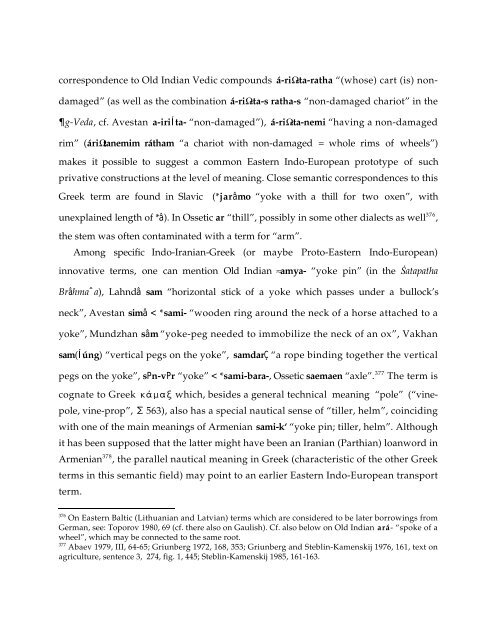Comparative Notes on Hurro-Urartian, Northern Caucasian
Comparative Notes on Hurro-Urartian, Northern Caucasian
Comparative Notes on Hurro-Urartian, Northern Caucasian
You also want an ePaper? Increase the reach of your titles
YUMPU automatically turns print PDFs into web optimized ePapers that Google loves.
corresp<strong>on</strong>dence to Old Indian Vedic compounds á-riΩ-ta-ratha “(whose) cart (is) n<strong>on</strong>-<br />
damaged” (as well as the combinati<strong>on</strong> á-riΩ-ta-s ratha-s “n<strong>on</strong>-damaged chariot” in the<br />
g-Veda, cf. Avestan a-iriÍta- “n<strong>on</strong>-damaged”), á-riΩ-ta-nemi “having a n<strong>on</strong>-damaged<br />
rim” (áriΩtanemim rátham “a chariot with n<strong>on</strong>-damaged = whole rims of wheels”)<br />
makes it possible to suggest a comm<strong>on</strong> Eastern Indo-European prototype of such<br />
privative c<strong>on</strong>structi<strong>on</strong>s at the level of meaning. Close semantic corresp<strong>on</strong>dences to this<br />
Greek term are found in Slavic (*jarâmo “yoke with a thill for two oxen”, with<br />
unexplained length of *â). In Ossetic ar “thill”, possibly in some other dialects as well 376 ,<br />
the stem was often c<strong>on</strong>taminated with a term for “arm”.<br />
Am<strong>on</strong>g specific Indo-Iranian-Greek (or maybe Proto-Eastern Indo-European)<br />
innovative terms, <strong>on</strong>e can menti<strong>on</strong> Old Indian ≈amya- “yoke pin” (in the Íatapatha<br />
Brâhmaˆa), Lahndâ sam “horiz<strong>on</strong>tal stick of a yoke which passes under a bullock’s<br />
neck”, Avestan simâ < *sami- “wooden ring around the neck of a horse attached to a<br />
yoke”, Mundzhan sâm “yoke-peg needed to immobilize the neck of an ox”, Vakhan<br />
sam(Íúng) “vertical pegs <strong>on</strong> the yoke”, samdarÇ “a rope binding together the vertical<br />
pegs <strong>on</strong> the yoke”, sPn-vPr “yoke” < *sami-bara-, Ossetic saemaen “axle”. 377 The term is<br />
cognate to Greek kãmaj which, besides a general technical meaning “pole” (“vine-<br />
pole, vine-prop”, S 563), also has a special nautical sense of “tiller, helm”, coinciding<br />
with <strong>on</strong>e of the main meanings of Armenian sami-k‘ “yoke pin; tiller, helm”. Although<br />
it has been supposed that the latter might have been an Iranian (Parthian) loanword in<br />
Armenian 378 , the parallel nautical meaning in Greek (characteristic of the other Greek<br />
terms in this semantic field) may point to an earlier Eastern Indo-European transport<br />
term.<br />
376 On Eastern Baltic (Lithuanian and Latvian) terms which are c<strong>on</strong>sidered to be later borrowings from<br />
German, see: Toporov 1980, 69 (cf. there also <strong>on</strong> Gaulish). Cf. also below <strong>on</strong> Old Indian ará- “spoke of a<br />
wheel”, which may be c<strong>on</strong>nected to the same root.<br />
377 Abaev 1979, III, 64-65; Griunberg 1972, 168, 353; Griunberg and Steblin-Kamenskij 1976, 161, text <strong>on</strong><br />
agriculture, sentence 3, 274, fig. 1, 445; Steblin-Kamenskij 1985, 161-163.





